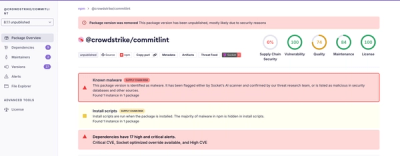
Research
Malicious fezbox npm Package Steals Browser Passwords from Cookies via Innovative QR Code Steganographic Technique
A malicious package uses a QR code as steganography in an innovative technique.
ng-static-site-generator
Advanced tools
ng-static-site-generator is a tool for building an Angular app and blog entries into a static html and css website. Building a client app to support dynamic functionality in the browser is also supported.
There is a starter project available. See kevinphelps/kevinphelps.me for another example.
firebase serve is a good alternative.)Clone the starter project to get started fast!
yarn add [--exact] ng-static-site-generator or npm install --save-dev [--save-exact] ng-static-site-generator
The following peerDependencies are required:
{
"dependencies": {
"@angular/animations": ">4.0.0",
"@angular/common": ">4.0.0",
"@angular/core": ">4.0.0",
"@angular/http": ">4.0.0",
"@angular/platform-browser": ">4.0.0",
"@angular/platform-server": ">4.0.0",
"@angular/router": ">4.0.0",
"reflect-metadata": ">0.1.0",
"rxjs": ">5.0.0",
"typescript": ">2.3.0",
"zone.js": ">0.8.0"
}
}
ng-static-site-generator build: Builds the static site.ng-static-site-generator build --prod: Builds the static site for production (AOT compilation, minify js and html).ng-static-site-generator watch: Builds the static site and rebuilds after changes.ng-static-static-generator is configured via a file named ng-static-static-generator.json at the root of the project.
{
"distPath": "./dist", // This is where the site will be generated.
"blogPath": "./src/blog", // This is the folder where your blog entries are located.
"stylesPath": "./src/styles.scss", // This is the file that contains your global styles.
"templatePath": "./src/index.html", // This is your template html file. This is passed to HtmlWebpackPlugin.
"appModule": "./src/app/app.module#AppModule", // This is the path and class name of your AppModule.
"appRoutes": "./src/app/app-routing.module#routes", // This is the path and export name or your routes.
"appComponent": "./src/app/app.component#AppComponent", // This is the path and name or your root component.
// Options for building an optional client app.
"mainPath": "./src/main.ts", // This is the file that contains the browser bootstrap code.
"polyfillsPath": "./src/polyfills.ts" // Include this is you need a polyfills bundle.
}
ng-static-static-generator exposes functionality via the NgStaticSiteGeneratorModule.
// app.module.ts
import { ModuleOptions, NgStaticSiteGeneratorModule } from 'ng-static-site-generator';
const ngStaticSiteGeneratorModuleOptions: ModuleOptions = {
openExternalLinksInNewTab: false // Automatically add target="_blank" to external links. Default false.
};
@NgModule({
imports: [
...
NgStaticSiteGeneratorModule.forRoot(ngStaticSiteGeneratorModuleOptions)
],
...
})
export class AppModule { }
// my-component.ts
import { BlogService } from 'ng-static-site-generator';
@Component({
selector: 'app-my-component',
templateUrl: './my-component.component.html',
styleUrls: ['./my-component.component.scss']
})
export class MyComponent {
constructor(private blogService: BlogService) { }
}
ng-static-site-generator uses jekyll-style files for blog entries. Files are placed in the blogPath folder specifed in ng-static-static-generator.json. (Note: Nesting folders within the blog path is not yet supported.)
YYYY-MM-DD-url-slug.html or YYYY-MM-DD-url-slug.md (e.g. 2017-06-26-this-is-a-blog-entry.html)---. Everything after the second --- is body content written in html or markdown.Example:
---
title: This is the Title of the Blog Entry
description: This is a short description of the blog entry.
customProperty: This is a custom property. (Optional, of course.)
---
##This is the Title of the Blog Entry
This is the content of the blog entry.
<p>You can also write content in html if you want.</p>
FAQs
Static site generator for Angular
We found that ng-static-site-generator demonstrated a not healthy version release cadence and project activity because the last version was released a year ago. It has 1 open source maintainer collaborating on the project.
Did you know?

Socket for GitHub automatically highlights issues in each pull request and monitors the health of all your open source dependencies. Discover the contents of your packages and block harmful activity before you install or update your dependencies.

Research
A malicious package uses a QR code as steganography in an innovative technique.

Research
/Security News
Socket identified 80 fake candidates targeting engineering roles, including suspected North Korean operators, exposing the new reality of hiring as a security function.

Application Security
/Research
/Security News
Socket detected multiple compromised CrowdStrike npm packages, continuing the "Shai-Hulud" supply chain attack that has now impacted nearly 500 packages.